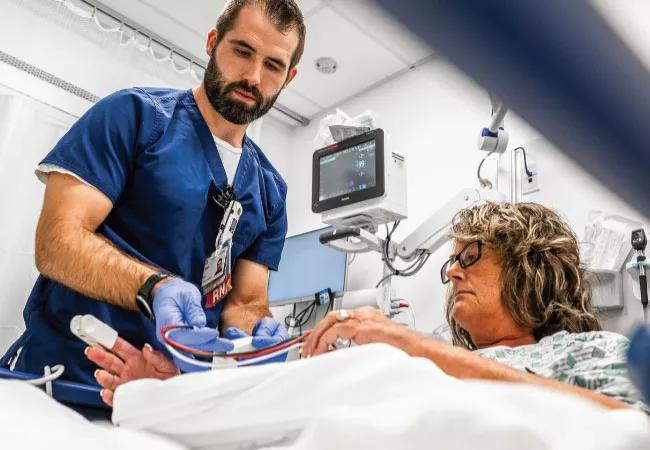Akron General and Union Hospital increase throughput and patient satisfaction by rethinking their approach to care

Despite national trends, Cleveland Clinic Akron General and its three satellite facilities in Bath, Green and Stow have seen a dramatic decrease in the number of ED patients who LBTC since 2020, when the hospital began to implement several plans designed to decrease department crowding and improve communication.
Advertisement
Cleveland Clinic is a non-profit academic medical center. Advertising on our site helps support our mission. We do not endorse non-Cleveland Clinic products or services. Policy
“Emergency department volumes can be difficult to predict, but we’re able to prepare by staffing the unit according to historical trends,” explains Julie Gorecki, MBA, BSN, RN, NEA-BC, Associate Chief Nursing Officer at Akron General. “Losing someone prior to the completion of their visit can obviously be dangerous for the patient, but these situations are also lost opportunities for the healthcare system. Fortunately, we’ve learned how to change our approach in a way that alleviates strain not only on patients who are at risk of LBTC, but also on our nursing staff and the ED itself.”
As a nurse manager in Cleveland Clinic Union Hospital’s ED, Charli Landis, MSN, APRN-CNP, NE-BC, has also seen a downward trend in the number of patients who LBTC. After the ED adopted several new patient retention strategies in late 2021, the number of “lost” patients dropped from 22% to 2.9% in 2022 — one of the lowest rates in the entire Cleveland Clinic enterprise, she says.
Both Gorecki and Landis insist that caregiver collaboration is crucial to the success of their efforts, as is fostering a culture that values the input of nurses.
“We know teamwork improves clinical care, outcomes and patient experience,” explains Gorecki. “It also encourages staff engagement, which makes caregivers happy to come to work and reminds them that they can succeed.” She adds that strong, involved ED leaders who express appreciation for their staff also play a pivotal role in the success of these initiatives by “setting a positive tone for their departments.”
Advertisement
When high clinical volumes threaten to interrupt flow in the Bath, Green and Stow health and wellness center EDs, Gorecki says the staff are prepared to open nontraditional clinical spaces, including conference and evaluation rooms, for patient care. By bringing in vital sign equipment and blood-draw carts, the team can create a makeshift split-flow area where patient care can be provided.
“Our clinicians are highly engaged in the ED process and focused on reducing unnecessary delays,” says Gorecki. “There are no ‘weekends’ here; we must be ready to provide emergency care every day of the year. If X-rays or an echocardiogram are needed on a Saturday, a caregiver will be here to perform the test — and ideally, get the patient discharged so the bed can be open for someone who needs it.”
The Akron General ED also features a split-flow area for low-acuity patients, which is staffed by a nurse and an advanced practice provider (APP). This strategy allows patients who don’t require admission to be discharged more efficiently, explains Gorecki. The ED also features an internal waiting room inside the triage area, which enables staff to keep a closer eye on sicker patients without having to send them back to the main waiting room.
Concerned that high-risk patients were leaving the ED before receiving a full evaluation, both Union Hospital and Akron General kicked off their new approach by stationing an APP in their triage areas. Working alongside a nurse, the APP can initiate medical tests and a screening exam in the critical first minutes of a patient’s arrival.
Advertisement
“Assessing and testing patients faster improves our ability to identify potentially life-threatening conditions sooner, particularly obscure illnesses that can be more difficult to recognize with a more limited triage evaluation,” says Landis. “The strategy also makes patients happier because it usually allows them to be seen by a clinician within minutes of arrival.”
Gorecki adds that the extra clinical support “really keeps things moving and allows us to quickly identify what a patient requires.” In the event of staffing shortages or increased ED volume, medical-surgical and critical care nurses are also brought in to help with patient care, and paramedics or trained clinical technicians may be brought in to draw blood.
In addition, Union Hospital has instituted nurse-initiated protocol orders, which help reduce administrative hiccups that can lengthen wait times. “Understandably, patients get upset when they’re forced to sit for long periods — and this ‘downtime’ can create the perception that the ED staff is doing little to help,” says Landis. “Now, our nurses can initiate care based on the patient’s chief complaint. Anything additional can be ordered once they see the APP, but the process helps us better serve our patients by avoiding unnecessary delays.”
Landis’s team has also stationed a “tasker” in the triage area who is responsible for completing orders, thus allowing the triage nurse to see one patient right after the other.
Based on research literature, patients often signal their desire to leave the ED before they actually do. One key to preventing premature departures, says Landis, is to pay close attention to what patients are saying with both their words and their body language.
Advertisement
“It’s important to be able to interpret their verbal and nonverbal cues,” Landis says. “Nurses can often calm an agitated or concerned patient by simply responding to their concerns with genuine understanding. By answering their questions and providing whatever comfort we can, we often defuse high-risk situations before they escalate. Most patients don’t want to leave the ED without being seen, and we can discourage them from doing so by initiating care when they come through the door.”
During Akron General ED’s peak hours of 3 to 11 p.m., a two-person evaluation team consisting of a physician and a clinical nurse engages with patients while they’re still in the waiting room. Even low-acuity patients may find this waiting period to be uncomfortable or frustrating, circumstances that can increase the risk they may LBTC, explains Gorecki. To address this problem, the Akron team developed a protocol that involves frequent gestures of reassurance.
“We know that patients are far more tempted to leave the ED if they feel ignored,” says Gorecki. “We’ve found that even brief interactions can provide the support patients need to stay. By talking with them every hour or so and rechecking their vital signs while they’re still in the waiting room, we let our patients know that we care about them, value their time and are invested in their well-being.”
This approach has become integral at Union Hospital as well. “Although it seems obvious, it means so much to people when you take time to explain, ‘We haven’t forgotten about you!’” says Landis. “Even a simple update like ‘We’re going to start the process out here, but we’ll put you in a bed as soon as one becomes available’ can make a tremendous difference.”
Advertisement
Furthermore, by communicating estimated wait times and the availability of immediate treatments for minor injuries or symptoms, EDs may be able to increase the amount of time that patients are willing to wait, adds Landis.
“Simply put, patients want to feel seen and heard,” she says. “By keeping the lines of communication open and acknowledging whatever problem has led them to the ED that day, we also increase patients’ confidence in us.”
1. Janke AT, Melnick ER, Venkatesh AK. Monthly Rates of Patients Who Left Before Accessing Care in US Emergency Departments, 2017-2021. JAMA Netw Open. 2022;5(9):e2233708.
Advertisement

This technical solution expedites the patient’s ED to admissions process

Remotely based physicians use telehealth technology to evaluate lower-acuity patients in the ED, express clinic or during an EMS response

Peer-to-peer videos offer creative solution to help patients while they wait

Guiding nurses amid a constantly evolving healthcare landscape

Ideation session generates solutions to medication administration errors

Caregivers spearhead changes that improve patient care, shape hospital culture

Building a culture that supports, engages and empowers nursing staff

Nurses harness cutting-edge technology as a bridge to healing